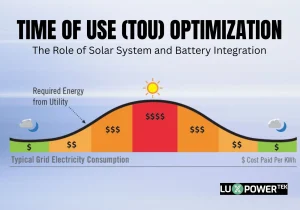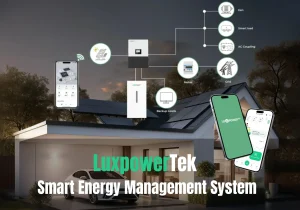我们对电力的依赖日益加深。此外,世界各国都在努力减少对化石燃料的依赖。根据2025年的预测,我们看到今年电动汽车的使用量增加了2000万辆。如果每辆汽车都使用40千瓦时的电池,那么想象一下这会增加多少电力消耗。在这种情况下,使用时间(TOU)是一个至关重要的术语。
我们还可以从许多其他方面观察到电的使用。例如,空调、用电炉代替燃气灶、微波炉或电烤箱等等,都列在这个清单上。
现在的问题是,我们如何才能优化这些电力的使用时间?这样做,你的电费将大大减少。
了解使用时间 (TOU)

分时电价,简称TOU,是一种根据一天中不同时段电价变化的电力管理系统。
办公室、法院、市场和购物中心通常在白天开放。这些时段的电力需求显著增加,因此电价相对较高。另一方面,夜间电力需求较低时,电价也会低得多。
为了优化电力使用,请考虑采取几种措施。
优化时间利用的最有效方法之一是使用太阳能。外面阳光无限,何不好好利用呢?在用电高峰时段,您可以依靠太阳能,并将多余的电能储存在电池中。虽然初始设置可能成本高昂,但随着时间的推移,事实证明这是一种非常经济高效的解决方案。
您还可以使用智能家电来优化用电时间 (TOU)。有些设备允许您远程控制用电。即使您不在家,也可以控制恒温器、充电器或其他设备。此外,您还可以利用净计量功能。
什么是分时电价?
分时电价通常是电力定价方案。它根据一天中的时间而变化。通常分为两个时段:高峰时段和非高峰时段。高峰时段电力需求异常高,电价较高。另一方面,非高峰时段需求较低,电价较低。
公用事业公司会设置不同的电费周期。电费周期通常设置在不同的时间,包括早上、下午、晚上和夜间。在某些地区或国家,电费周期可能会在中峰时段计算。这些电费周期会鼓励您将能源使用时间转移到非高峰时段。
TOU电价在许多地区很常见。它通常有助于减轻电网压力。对于这种类型的设置,通常需要智能电表。
利用太阳能系统优化使用时间(TOU)
太阳能是最受欢迎的绿色能源系统之一。今年,它在家庭和商业应用中都获得了显著的普及。使用太阳能系统是优化使用时间 (TOU) 的好方法。
太阳能电池板通常在白天发电。而白天电价昂贵。因此,太阳能系统可以减少人们对电网的依赖。如果与电池储能系统结合使用,则可以在高峰时段储存多余的电能。这同样可以减少对高价电力的依赖。
在这种情况下,我们不能忽视太阳能逆变器的作用。它是控制整个系统的核心技术,在优化分时电价(TOU)方面也发挥着至关重要的作用。
智能能源管理

太阳能逆变器通常实时监控能源生产和消耗。即使您不在家,也可以控制此设备。无论是通过移动应用程序还是网页应用程序,您都可以根据分时电价 (TOU) 在太阳能电池和电网之间切换。这样,您可以在高峰时段使用储能或太阳能来降低成本。总而言之,它确保高效利用电力,每天节省金钱和能源。
电池集成与控制
大多数现代太阳能逆变器都设计用于与电池储能系统配合使用。更先进的逆变器可以决定何时储能以及何时使用。通常情况下,它们会在白天储存多余的太阳能。在夜间或电价高峰期,它们会释放储存的电能。这样,您可以节省电费。
基于TOU的调度
现代太阳能逆变器(例如 LXP 逆变器)还支持自定义能源使用计划。您可以设置时间段,优先使用太阳能或电池供电。逆变器通常遵循此 TOU 计划来降低能源成本。它主要根据电价自动进行电力转换。
电网互动与反馈
LXP 逆变器还提供净计量功能。它与电网系统互动,无论是使用电网电力还是出售多余的太阳能发电。在分时电价 (TOU) 较低时,这些逆变器可以储存电网电能。在高需求时段,它们有助于降低电网需求。您可以在您的私人虚拟电厂上控制所有这些功能。
系统性能优化
太阳能逆变器还能跟踪和分析系统数据。LXP 逆变器可以检测系统中的低效环节。这样,您就可以确保太阳能系统以最佳状态运行。保持最佳性能可以减少能量损失。
电动汽车充电和 TOU 优化
大多数电动汽车配备 40kWh 电池。如果在高峰时段充电,这些电池的充电成本可能会很高。在这种情况下,分时电价优化可以帮助您降低成本。
您通常可以采取一些必要的措施来优化成本。尽量在分时电价较低时(尤其是在夜间)为您的电动汽车充电。您还可以设置电动汽车充电的开始时间。请注意,大多数电动汽车充电器都带有此功能。此外,您还可以使用应用程序远程控制充电。
带电池的太阳能系统也可以为您的电动汽车储存电能。这些电能是免费的,您可以在白天通过太阳能电池板发电。这样,您可以显著降低电动汽车充电成本,节省开支,并最大限度地减少电网负荷。
关键要点
由于电动汽车和智能家电的兴起,电力需求不断增长。分时电价 (TOU) 可以帮助您显著降低这部分成本。夜间电价通常较低,而高峰时段电价较高。
太阳能是管理分时用电 (TOU) 的明智之选。在这种情况下,选择合适的太阳能逆变器至关重要。智能逆变器(例如 LXP 逆变器)可让您安排并远程控制整个系统。
此外,电池储能系统还能在电价高涨的时期帮助能源利用。另一方面,净计量系统则允许您将多余的电力回售给电网。总而言之,分时电价优化可以节省成本并支持电网。结合智能工具利用太阳能,可以更有效地管理日常能源。

